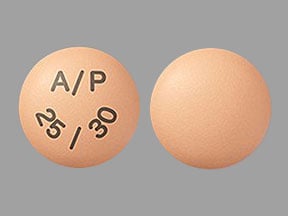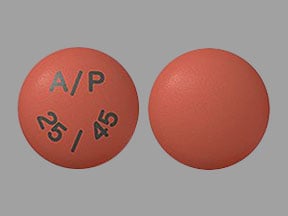Oseni
Generic name: alogliptin and pioglitazone
Drug class: Antidiabetic combinations
Medically reviewed by A Ras MD.
What is Oseni?
Oseni contains 2 prescription diabetes medicines, alogliptin (NESINA) and pioglitazone (ACTOS).
Oseni is a prescription medicine used along with diet and exercise to improve blood sugar (glucose) control in adults with type 2 diabetes.
Oseni is not for people with type 1 diabetes.
It is not known if Oseni is safe and effective in children under the age of 18. Oseni is not recommended for use in children.
Description
OSENI tablets contain two oral antihyperglycemic drugs used in the management of type 2 diabetes: alogliptin and pioglitazone.
Alogliptin
Alogliptin is a selective, orally bioavailable inhibitor of the enzymatic activity of dipeptidyl peptidase-4 (DPP-4). Chemically, alogliptin is prepared as a benzoate salt, which is identified as 2-({6-[(3R)-3-aminopiperidin-1-yl]-3-methyl-2,4-dioxo-3,4-dihydropyrimidin-1(2H)-yl}methyl)benzonitrile monobenzoate. It has a molecular formula of C18H21N5O2∙C7H6O2 and a molecular weight of 461.51 daltons. The structural formula is:
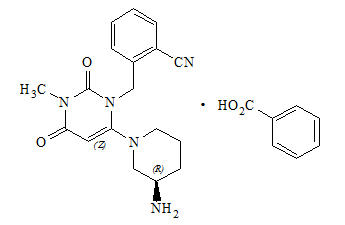
Alogliptin benzoate is a white to off-white crystalline powder containing one asymmetric carbon in the aminopiperidine moiety. It is soluble in dimethylsulfoxide, sparingly soluble in water and methanol, slightly soluble in ethanol and very slightly soluble in octanol and isopropyl acetate.
Pioglitazone
Pioglitazone is an oral antihyperglycemic agent that acts primarily by decreasing insulin resistance. Chemically, pioglitazone is prepared as hydrochloride salt, which is identified as (±)-5-[[4-[2-(5-ethyl-2-pyridinyl)ethoxy]phenyl]methyl]-2,4-thiazolidinedione monohydrochloride. It has a molecular formula of C19H20N2O3S∙HCl and a molecular weight of 392.90 daltons. The structural formula is:

Pioglitazone hydrochloride is an odorless white crystalline powder that contains one asymmetric carbon in the thiazolidinedione moiety. The synthetic compound is a racemate and the two enantiomers of pioglitazone interconvert in vivo. It is soluble in N,N dimethylformamide, slightly soluble in anhydrous ethanol, very slightly soluble in acetone and acetonitrile, practically insoluble in water and insoluble in ether.
What is the most important information I should know about Oseni?
Oseni can cause serious side effects, including:
1. Heart failure: Heart failure means your heart does not pump blood well enough. Oseni can cause heart failure and cause your body to keep extra fluid (fluid retention), which leads to swelling (edema) and weight gain. Extra body fluid can make some heart problems worse or lead to heart failure.
Before you start taking Oseni:
Tell your doctor if you have ever had heart failure or have problems with your kidneys.
Call your doctor right away if you have any of the following symptoms:
- increasing shortness of breath or trouble breathing, especially when you lie down
- an unusually fast increase in weight
- swelling or fluid retention, especially in the feet, ankles, or legs
- unusual tiredness
These may be symptoms of heart failure.
2. Inflammation of the pancreas (pancreatitis): Alogliptin, one of the medicines in Oseni, may cause pancreatitis, which may be severe. Certain medical conditions make you more likely to get pancreatitis.
Before you start taking Oseni:
Tell your doctor if you have ever had:
- pancreatitis
- high blood triglyceride levels
- kidney problems
- stones in your gallbladder (gall stones)
- liver problems
- a history of alcoholism
Stop taking Oseni and call your doctor right away if you have pain in your stomach area (abdomen) that is severe and will not go away. The pain may be felt going from your abdomen through to your back. The pain may happen with or without vomiting. These may be symptoms of pancreatitis.
Mechanism of Action
OSENI combines two antihyperglycemic agents with complementary and distinct mechanisms of action to improve glycemic control in patients with type 2 diabetes: alogliptin, a selective inhibitor of DPP-4, and pioglitazone, a member of the TZD class.
Who should not take Oseni?
Do not take Oseni if you:
- have severe heart failure
- are allergic to alogliptin (NESINA), pioglitazone (ACTOS) or any ingredient in Oseni or have had a serious allergic (hypersensitivity) reaction to alogliptin or pioglitazone. See the end of this Medication Guide for a complete list of the ingredients in Oseni.Symptoms of a serious allergic reaction to Oseni may include:
- swelling of your face, lips, throat and other areas on your skin
- difficulty with swallowing or breathing
- raised, red areas on your skin (hives)
- skin rash, itching, flaking or peeling
If you have these symptoms, stop taking Oseni and contact your doctor or go to the nearest hospital emergency room right away.
What should I tell my healthcare provider before taking Oseni?
Before you start taking Oseni, tell your doctor if you:
- have heart failure
- have a type of diabetic eye disease that causes swelling of the back of the eye (macular edema)
- have kidney or liver problems
- have or have had inflammation of the pancreas (pancreatitis)
- have or have had cancer of the bladder
- have other medical conditions
- are pregnant or plan to become pregnant. It is not known if Oseni can harm your unborn baby. Talk to your doctor about the best way to control your blood sugar while you are pregnant or if you plan to become pregnant.
- are a premenopausal woman who does not have periods regularly or at all. Oseni may increase your chance of becoming pregnant. Talk to your doctor about birth control choices while taking Oseni. Tell your doctor right away if you become pregnant while taking Oseni.
- are breastfeeding or plan to breastfeed. It is not known if Oseni passes into your breast milk and if it can harm your baby. Talk with your doctor about the best way to control your blood glucose levels while breastfeeding.
Tell your doctor about all the medicines you take, including prescription and over-the-counter medicines, vitamins and herbal supplements.
Know the medicines you take. Keep a list of them and show it to your doctor and pharmacist before you start a new medicine.
Oseni may affect the way other medicines work, and other medicines may affect how Oseni works. Contact your doctor before you start or stop other types of medicines.
How should I take Oseni?
- Take Oseni exactly as your doctor tells you to take it.
- Take Oseni 1 time each day with or without food.
- Do not break or cut Oseni tablets before swallowing.
- Your doctor may need to change your dose of Oseni to control your blood glucose. Do not change your dose unless told to do so by your doctor.
- If you miss a dose, take it as soon as you remember. If you do not remember until it is time for your next dose, skip the missed dose and take the next dose at your regular time. Do not take 2 doses of Oseni at the same time.
- If you take too much Oseni, call your doctor or your poison control center right away at 1-800-222-1222.
- If your body is under stress, such as from fever, infection, accident or surgery, the dose of your diabetes medicines may need to be changed. Call your doctor right away.
- Stay on your diet and exercise programs and check your blood sugar as your doctor tells you to.
- Your doctor may do certain blood tests before you start Oseni and during treatment as needed. Your doctor may change your dose of Oseni based on the results of your blood tests due to how well your kidneys are working.
- Your doctor will check your diabetes with regular blood tests, including your blood sugar levels and your hemoglobin A1C.
- Your doctor should check your eyes regularly while you take Oseni.
What are the possible side effects of Oseni?
Oseni can cause serious side effects, including:
- See “What is the most important information I should know about Oseni?”
- Serious allergic (hypersensitivity) reactions, such as:
- swelling of your face, lips, throat and other areas on your skin
- difficulty swallowing or breathing
- raised, red areas on your skin (hives)
- skin rash, itching, flaking or peeling
If you have these symptoms, stop taking Oseni and contact your doctor right away or go to the nearest hospital emergency room
- Liver problems. Call your doctor right away or go to the nearest hospital emergency room if you have unexplained symptoms such as:
- nausea or vomiting
- stomach pain
- unusual or unexplained tiredness
- loss of appetite
- dark urine
- yellowing of your skin or the whites of your eyes
- Broken bones (fractures). Usually in the hand, upper arm or foot in women. Talk to your doctor for advice on how to keep your bones healthy.
- Bladder cancer. There may be an increased chance of having bladder cancer when you take Oseni. You should not take Oseni if you are receiving treatment for bladder cancer. Tell your doctor right away if you have any of the following symptoms of bladder cancer:
- blood or a red color in your urine
- an increased need to urinate
- pain while you urinate
- Low blood sugar (hypoglycemia). If you take Oseni with another medicine that can cause low blood sugar, such as a sulfonylurea or insulin, your risk of getting low blood sugar is higher. The dose of your sulfonylurea medicine or insulin may need to be lowered while you take Oseni. If you have symptoms of low blood sugar, you should check your blood sugar and treat if low, then call your doctor. Signs and symptoms of low blood sugar may include:
- shaking or feeling jittery
- sweating
- fast heartbeat
- change in vision
- hunger
- headache
- change in mood
- confusion
- dizziness
- Diabetic eye disease with swelling in the back of the eye (macular edema). Tell your doctor right away if you have any changes in your vision. Your doctor should check your eyes regularly.
- Release of an egg from an ovary in a woman (ovulation) leading to pregnancy. Ovulation may happen when premenopausal women who do not have regular monthly periods take Oseni. This can increase your chance of getting pregnant.
- Joint pain. Some people who take medicines called DPP-4 inhibitors, one of the medicines in Oseni, may develop joint pain that can be severe. Call your doctor if you have severe joint pain.
- Skin reaction. Some people who take medicines called DPP-4 inhibitors, one of the medicines in Oseni, may develop a skin reaction called bullous pemphigoid that can require treatment in a hospital. Tell your doctor right away if you develop blisters or the breakdown of the outer layer of your skin (erosion). Your doctor may tell you to stop taking Oseni.
The most common side effects of Oseni include stuffy or runny nose and sore throat, back pain, cold-like symptoms (upper respiratory tract infection).
Tell your doctor if you have any side effect that bothers you or that does not go away.
These are not all the possible side effects of Oseni. For more information, ask your doctor or pharmacist.
Call your doctor for medical advice about side effects. You may report side effects to FDA at 1-800-FDA-1088.
General information about the safe and effective use of Oseni
Medicines are sometimes prescribed for purposes other than those listed in the Medication Guide. Do not take Oseni for a condition for which it was not prescribed. Do not give Oseni to other people, even if they have the same symptoms you have. It may harm them.
This Medication Guide summarizes the most important information about Oseni. If you would like to know more information, talk with your doctor. You can ask your doctor or pharmacist for information about Oseni that is written for health professionals.
For more information, go to www.oseni.com or call 1-877-TAKEDA-7 (1-877-825-3327).
How should I store Oseni?
- Store Oseni at room temperature between 68°F to 77°F (20°C to 25°C).
- Keep container tightly closed and protect from moisture and humidity.
Keep Oseni and all medicines out of the reach of children.
What are the ingredients in Oseni?
Active ingredients: alogliptin and pioglitazone.
Inactive ingredients: mannitol, microcrystalline cellulose, hydroxypropyl cellulose, croscarmellose sodium, magnesium stearate, and lactose monohydrate; the tablets are film-coated with hypromellose, polyethylene glycol, titanium dioxide, talc and ferric oxide (yellow and/or red) and are marked with printing ink (Red A1 or Gray F1).
Label
PRINCIPAL DISPLAY PANEL – 12.5 mg/30 mg Tablet Bottle Label
- NDC 64764-123-03
- Oseni
(alogliptin and
pioglitazone) tablets - 12.5 mg/30 mg
- Rx Only
- Dispense with
Medication Guide - Takeda
- 30 Tablets
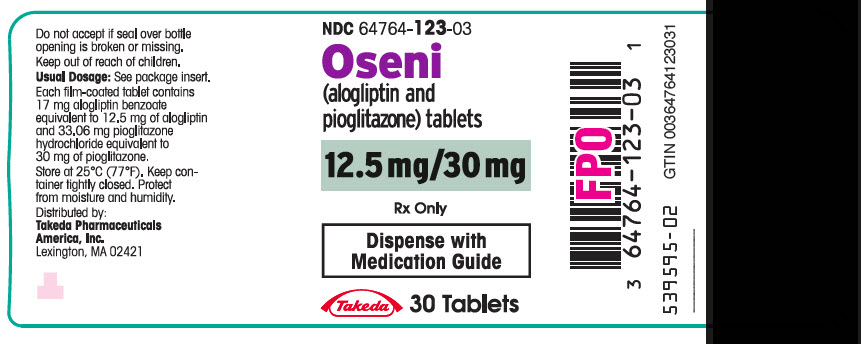
PRINCIPAL DISPLAY PANEL – 12.5 mg/45 mg Tablet Bottle Label
- NDC 64764-124-03
- Oseni
(alogliptin and
pioglitazone) tablets - 12.5 mg/45 mg
- Rx Only
- Dispense with
Medication Guide - Takeda
- 30 Tablets

PRINCIPAL DISPLAY PANEL – 25 mg/15 mg Tablet Bottle Label
- NDC 64764-251-03
- Oseni
(alogliptin and
pioglitazone) tablets - 25 mg/15 mg
- Rx Only
- Dispense with
Medication Guide - Takeda
- 30 Tablets
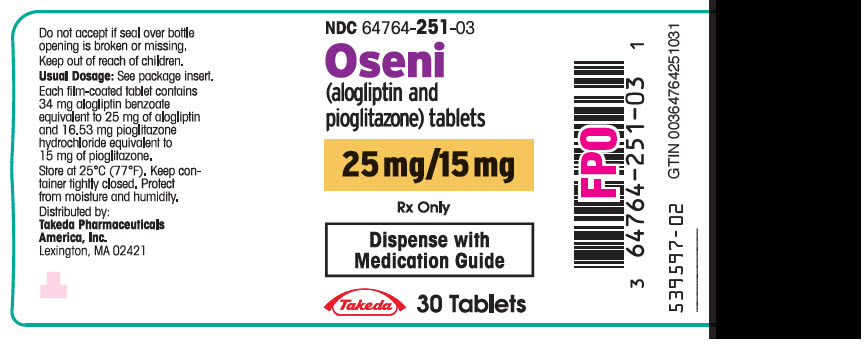
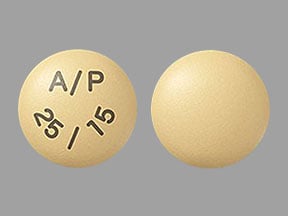
SRC: NLM .

